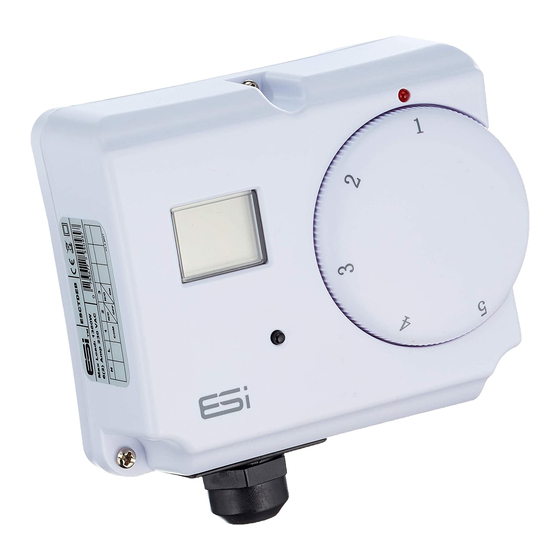Summary of Contents for ESI ESCTDE
- Page 1 ESCTDE Electronic Dual Cylinder Thermostat User and Installation Instructions Patent pending...
-
Page 3: Table Of Contents
INDEX User Instructions What is a Cylinder Thermostat? Introduction to the CTDE Holiday Switch Installation Instructions Technical Data Installation Safety Instructions General Safety Instructions Maintenance Safety Notice Fitting the Cylinder Thermostat Adjusting and Resetting the Cylinder Thermostat Wiring Example... -
Page 4: User Instructions
User Instructions... -
Page 5: What Is A Cylinder Thermostat
What is a Cylinder Thermostat? ...An explanation for householders A cylinder thermostat switches on and off the heat supply from the boiler to the hot-water cylinder. It works by sensing the tempera- ture of the water inside the cylinder, switching on the water heating when the temperature falls below the thermostat setting, and switching it off... -
Page 6: Introduction To The Ctde
Introduction to the ESCTDE (Electronic Dual Cylinder Thermostat) The ESi Controls Electronic Dual Cylinder Thermostat* is a revolutionary new energy saving product, developed exclusively by ESi Controls. It is a direct** and economical replacement for traditional mechanical dual cylinder thermostats. - Page 7 sensitive electronic sensors operate at a far greater accuracy than conventional oil filled mechanical dual thermostats, and do not need physical contact unlike traditional dual thermostats. The large dial makes it easy to set the required controller temperature (between C and 65 C).
-
Page 8: Holiday Switch
10 seconds until you hear an audible click, and this switches the ESCTDE off completely so there is no water heating and no weekly “boost” heating. When in Holiday mode, the display is off. This feature should only be used when the property is vacant for extended periods and there is no requirement for water heating or for the weekly “boost”. -
Page 9: Installation Instructions
Installation Instructions... -
Page 10: Technical Data
Technical Data Electronic Dual Thermostat Power Supply Power Supply 230 VAC 50-60Hz Switch Action Switch Action SPDT (control), SPST (limit) Temperature Setting Range C to 65 Automated “Boost” Automated “Boost” Once per week, >60 C for one hour Limit Thermostat 230 VAC 50-60Hz Limit Thermostat C with concealed manual reset... -
Page 11: Installation Safety Instructions
Installation Safety Instructions The unit must be installed by a suitably qualified person in accordance with the latest IEE Wiring Regulations. N.B Isolate mains supply before commencing installation. Please read all instruc- tions before proceeding. Ensure that the fixed wiring connections to the mains supply is via a fuse rated at not more than 6 amps and class ‘A’... -
Page 12: Maintenance
Maintenance Always isolate the mains supply before commencing any work, servicing or mainte- nance on the system. And please read all instructions before proceeding. Arrange for an annual maintenance and inspection schedule to be carried out by a competent person on every part of the heating and hot water system. Safety Notice WARNING! ALWAYS ISOLATE THE AC MAINS SUPPLY BEFORE INSTALLING. -
Page 13: Fitting The Cylinder Thermostat
Fitting the Cylinder Thermostat 1. Slacken the three fixing screws, and insert both sensors fully into the pocket. 2. Position the thermostat onto the pocket. 3. Tighten the three screws to secure the thermostat, take care not to over tighten. 4. -
Page 14: Wiring Example
Wiring Example... - Page 15 Wiring Diagram Common Hot Water This product requires a fused permanent Live and Neutral supply.
- Page 16 ESi Controls Limited sales@esicontrols.co.uk www.esicontrols.co.uk Version 2.1...

















